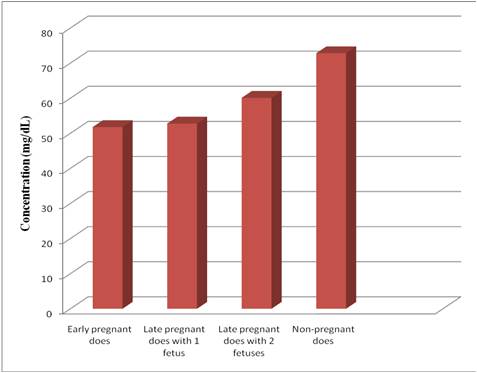Abstract
Pregnancy toxaemia is a multifactorial disorder of energy metabolism in small ruminants commonly occurs in the last month of gestation characterized by hypoglycemia, hyperketonemia and metabolic acidosis. Does carrying twins and triplets are at higher risk. In the present study 29 does select divided into four groups. Early pregnant, a late pregnant animal with one fetus, late pregnant animal with two fetuses and non-pregnant control group. The objective of this study was the detection of subclinical pregnancy toxaemia, metabolic profiling and assessment of inflammatory cytokines. Among the four groups selected the group of a late pregnant animal with two fetuses had a Beta-hydroxybutyrate level of 0.81 ± 0.10 mmol/l, which shows those animals were in subclinical pregnancy toxaemic stage. Hypoglycemia and hyper- ketonemia was a striking observation in that group. Serum concentration of Non-esterified fatty acid was increased in the same group with a noticeable increase in the Tumor necrosis factor alpha. This may be due to the inflammatory changes in response to metabolic acidosis as the acetoacetate and beta-hydroxybutyrate are powerful acids. The release of TNF-α implicating the role and importance of stress in the pathophysiology of the condition.
Full text article
Generated from XML file
Authors
Aswathy C, Shonima P, Rosemol Jacob, Vishnu Priya V, & Surapaneni Krishna Mohan. (2018). Metabolic profiling of Malabari does with subclinical pregnancy toxaemia. International Journal of Research in Pharmaceutical Sciences, 9(3), 911–916. Retrieved from https://ijrps.com/home/article/view/4371
Copyright (c) 2018 International Journal of Research in Pharmaceutical Sciences

This work is licensed under a Creative Commons Attribution-NonCommercial-NoDerivatives 4.0 International License.

